Related Research Articles
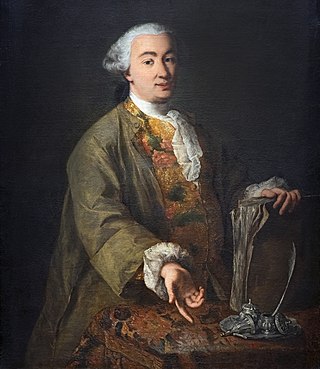
Carlo Osvaldo Goldoni was an Italian playwright and librettist from the Republic of Venice. His works include some of Italy's most famous and best-loved plays. Audiences have admired the plays of Goldoni for their ingenious mix of wit and honesty. His plays offered his contemporaries images of themselves, often dramatizing the lives, values, and conflicts of the emerging middle classes. Though he wrote in French and Italian, his plays make rich use of the Venetian language, regional vernacular, and colloquialisms. Goldoni also wrote under the pen name and title Polisseno Fegeio, Pastor Arcade, which he claimed in his memoirs the "Arcadians of Rome" bestowed on him.
A courtesan is a prostitute with a courtly, wealthy, or upper-class clientele. Historically, the term referred to a courtier, a person who attended the court of a monarch or other powerful person.
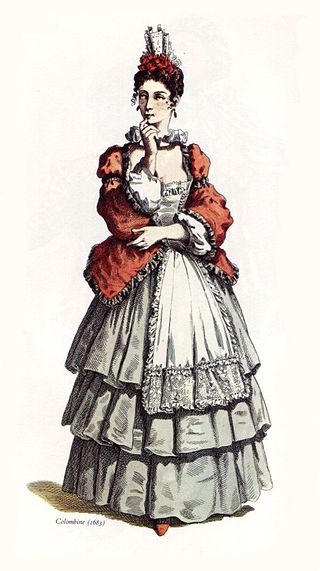
Columbina is a stock character in the commedia dell'arte. She is Harlequin's mistress, a comic servant playing the tricky slave type, and wife of Pierrot. Rudlin and Crick use the Italian spelling Colombina in Commedia dell'Arte: A Handbook for Troupes.

Carlo, Count Gozzi was an Italian (Venetian) playwright and champion of Commedia dell'arte.
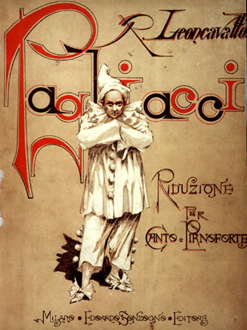
Pagliacci is an Italian opera in a prologue and two acts, with music and libretto by Ruggero Leoncavallo. The opera tells the tale of Canio, actor and leader of a commedia dell'arte theatrical company, who murders his wife Nedda and her lover Silvio on stage during a performance. Pagliacci premiered at the Teatro Dal Verme in Milan on 21 May 1892, conducted by Arturo Toscanini, with Adelina Stehle as Nedda, Fiorello Giraud as Canio, Victor Maurel as Tonio, and Mario Ancona as Silvio. Soon after its Italian premiere, the opera played in London and in New York. Pagliacci is the best-known of Leoncavallo's ten operas and remains a staple of the repertoire.
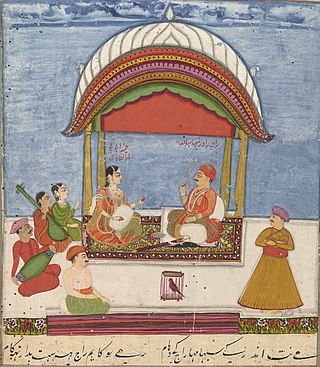
A tawaif was a highly successful courtesan singer‚ dancer‚ and poet who catered to the nobility of the Indian subcontinent, particularly during the Mughal era. Many tawaifs were forced to go into prostitution due to a lack of opportunities by the time of the British Raj.

Eduardo De FilippoOMRI, also known simply as Eduardo, was an Italian actor, director, screenwriter and playwright, best known for his Neapolitan works Filumena Marturano and Napoli Milionaria. Considered one of the most important Italian artists of the 20th century, De Filippo was the author of many theatrical dramas staged and directed by himself first and later awarded and played outside Italy. For his artistic merits and contributions to Italian culture, he was named senatore a vita by the President of the Italian Republic Sandro Pertini.

Isabella Andreini, also known as Isabella Da Padova, was an Italian actress and writer. Andreini was a member of the Compagnia dei Comici Gelosi, a touring theatre company that performed in Italy and France. The role of Isabella of the commedia dell'arte was named after her.
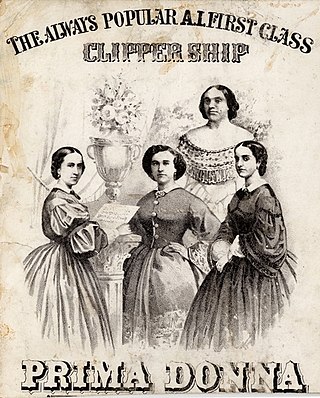
In opera or commedia dell'arte, a prima donna is the leading female singer in the company, the person to whom the prime roles would be given.
Theatres for diverse musical and dramatic presentations began to open in Naples, Italy, in the mid-16th century as part of the general Spanish cultural and political expansion into the kingdom of Naples, which had just become a vicerealm of Spain. None of the early theaters still function as such, having been replaced by later facilities from the mid-18th century onwards. Neapolitan theatres first built in the 16th and 17th centuries include:

The Museo Teatrale alla Scala is a theatrical museum and library attached to the Teatro alla Scala in Milan, Italy. Although it has a particular focus on the history of opera and of that opera house, its scope extends to Italian theatrical history in general, and includes displays relating, for example, to the commedia dell'arte and to the famous stage actress Eleonora Duse.

An actor or actress is a person who portrays a character in a production. The actor performs "in the flesh" in the traditional medium of the theatre or in modern media such as film, radio, and television. The analogous Greek term is ὑποκριτής (hupokritḗs), literally "one who answers". The actor's interpretation of a role—the art of acting—pertains to the role played, whether based on a real person or fictional character. This can also be considered an "actor's role", which was called this due to scrolls being used in the theaters. Interpretation occurs even when the actor is "playing themselves", as in some forms of experimental performance art.

Commedia dell'arte was an early form of professional theatre, originating from Italian theatre, that was popular throughout Europe between the 16th and 18th centuries. It was formerly called Italian comedy in English and is also known as commedia alla maschera, commedia improvviso, and commedia dell'arte all'improvviso. Characterized by masked "types", commedia was responsible for the rise of actresses such as Isabella Andreini and improvised performances based on sketches or scenarios. A commedia, such as The Tooth Puller, is both scripted and improvised. Characters' entrances and exits are scripted. A special characteristic of commedia is the lazzo, a joke or "something foolish or witty", usually well known to the performers and to some extent a scripted routine. Another characteristic of commedia is pantomime, which is mostly used by the character Arlecchino, now better known as Harlequin.
Vittoria Piisimi, was an Italian actress, singer, dancer, theatre director and musician. Known as la divina Vittoria Piisimi, she was one of the most famous Italian actors of the period. She and Isabella Andreini were the two most famed actresses of the era, and described as great rivals.
Vincenza Armani, was an Italian actress, singer, poet, musician, lace maker and sculptor. She was one of the most famous Italian actresses of the period and known as the 'Divine Vincenza Armani'. She and Barbara Flaminia were the two most known actresses of their time and described as great rivals. Being one of the two first well-documented actresses in Italy, which was the only country where actresses existed at the time, she belonged to the first actresses in modern Europe.
Flaminio Scala, commonly known by his stage name Flavio, was an Italian stage actor of commedia dell'arte, scenario writer, playwright, director, producer, manager, agent, and editor. Considered one of the most important figures in Renaissance theatre, Scala is remembered today as the author of the first published collection of commedia scenarios, Il Teatro delle Favole Rappresentative, short comic plays that served as inspiration to playwrights such as Lope de Vega, William Shakespeare, Ben Jonson, and Molière.

Virginia Ramponi-Andreini, also known by her stage name "La Florinda" was a celebrated Italian actress and singer. She was known for her performances in commedia dell'arte plays, many of them written for her by her husband Giambattista Andreini, and for having created the title role in Claudio Monteverdi's lost opera L'Arianna. She was born in Northern Italy in either Milan or Genoa. The exact date and place of her death are unknown.
Barbara Flaminia (1540–1586) was an Italian stage actress. She was one of the earliest actresses known in Europe and internationally known in her time. She and Vincenza Armani were the two most famed actresses in Italy in the 1560s and were described as great rivals.

The theatre of Italy originates from the Middle Ages, with its background dating back to the times of the ancient Greek colonies of Magna Graecia, in Southern Italy, the theatre of the Italic peoples and the theatre of ancient Rome. It can therefore be assumed that there were two main lines of which the ancient Italian theatre developed in the Middle Ages. The first, consisting of the dramatization of Catholic liturgies and of which more documentation is retained, and the second, formed by pagan forms of spectacle such as the staging for city festivals, the court preparations of the jesters and the songs of the troubadours.
References
- ↑ Mirella Schino, Dodici schede sul teatro italiano in Glynne Wickham, Storia del Teatro, Il Mulino, Bologna 1988
- ↑ Jan Sewell, Clare Smout, The Palgrave Handbook of the History of Women on Stage